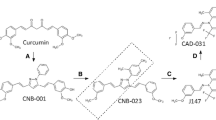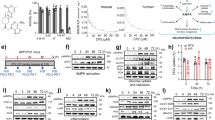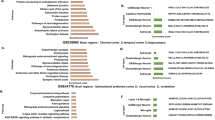Abstract
The understanding of how aging contributes to dementia remains obscure. To address this problem, a chemical biology approach was used employing CAD031, an Alzheimer’s disease (AD) drug candidate identified using a discovery platform based upon phenotypic screens that mimic toxicities associated with the aging brain. Since CAD031 has therapeutic efficacy when fed to old symptomatic transgenic AD mice, the chemical biology hypothesis is that it can be used to determine the molecular pathways associated with age-related disease by identifying those that are modified by the compound. Here we show that when CAD031 was fed to rapidly aging SAMP8 mice starting in the last quadrant of their lifespan, it reduced many of the changes in gene, protein, and small molecule expression associated with mitochondrial aging, maintaining mitochondria at the younger molecular phenotype. Network analysis integrating the metabolomics and transcription data followed by mechanistic validation showed that CAD031 targets acetyl-CoA and fatty acid metabolism via the AMPK/ACC1 pathway. Importantly, CAD031 extended the median lifespan of SAMP8 mice by about 30%. These data show that specific alterations in mitochondrial composition and metabolism highly correlate with aging, supporting the use AD drug candidates that limit physiological aging in the brain.






Similar content being viewed by others
References
Chen Q, Prior M, Dargusch R, Roberts A, Riek R, Eichmann C, et al. A novel neurotrophic drug for cognitive enhancement and Alzheimer's disease. PLoS One. 2011;6(12):e27865.
Cheng XR, Zhou WX, Zhang YX. The behavioral, pathological and therapeutic features of the senescence-accelerated mouse prone 8 strain as an Alzheimer’s disease animal model. Ageing Res Rev. 2014;13:13–37.
Chiruta C, Schubert D, Dargusch R, Maher P. Chemical modification of the multitarget neuroprotective compound fisetin. J Med Chem. 2012;55(1):378–89.
Currais A, Prior M, Lo D, Jolivalt C, Schubert D, Maher P. Diabetes exacerbates amyloid and neurovascular pathology in aging-accelerated mice. Aging Cell. 2012;11(6):1017–26.
Currais A, Goldberg J, Farrokhi C, Chang M, Prior M, Dargusch R, et al. A comprehensive multiomics approach toward understanding the relationship between aging and dementia. Aging (Albany NY). 2015;7(11):937–55.
Currais A, Farrokhi C, Dargusch R, Armando A, Quehenberger O, Schubert D, et al. Fisetin reduces the impact of aging on behavior and physiology in the rapidly aging SAMP8 mouse. J Gerontol A Biol Sci Med Sci. 2018;73(3):299–307.
Currais, A., et al., Elevating acetyl-CoA levels reduces aspects of brain aging. E-Life, 2019. 8: p. pii: 47866. https://doi.org/10.7554/eLife.47866. [Epub ahead of print].
Daugherty D, Goldberg J, Fischer W, Dargusch R, Maher P, Schubert D. A novel Alzheimer’s disease drug candidate targeting inflammation and fatty acid metabolism. Alzheimers Res Ther. 2017;9(1):50.
Davis JB, Maher P. Protein kinase C activation inhibits glutamate-induced cytotoxicity in a neuronal cell line. Brain Res. 1994;652(1):169–73.
de Magalhaes JP, Curado J, Church GM. Meta-analysis of age-related gene expression profiles identifies common signatures of aging. Bioinformatics. 2009;25(7):875–81.
Dobin A, Davis CA, Schlesinger F, Drenkow J, Zaleski C, Jha S, et al. STAR: ultrafast universal RNA-seq aligner. Bioinformatics. 2013;29(1):15–21.
Edgar R, Domrachev M, Lash AE. Gene expression omnibus: NCBI gene expression and hybridization array data repository. Nucleic Acids Res. 2002;30(1):207–10.
Goldberg J, et al. The mitochondrial ATP synthase is a shared drug target among aging and dementia. Aging Cell. 2018;2:e12715.
Huang d W, Sherman BT, Lempicki RA. Systematic and integrative analysis of large gene lists using DAVID bioinformatics resources. Nat Protoc. 2009a;4(1):44–57.
Huang d W, Sherman BT, Lempicki RA. Bioinformatics enrichment tools: paths toward the comprehensive functional analysis of large gene lists. Nucleic Acids Res. 2009b;37(1):1–13.
Li H, Slone J, Huang T. The role of mitochondrial-related nuclear genes in age-related common disease. Mitochondrion. 2020;53:38–47.
Lopez-Otin C, et al. The hallmarks of aging. Cell. 2013;153(6):1194–217.
McCarthy DJ, Chen Y, Smyth GK. Differential expression analysis of multifactor RNA-Seq experiments with respect to biological variation. Nucleic Acids Res. 2012;40(10):4288–97.
Morley JE, Armbrecht HJ, Farr SA, Kumar VB. The senescence accelerated mouse (SAMP8) as a model for oxidative stress and Alzheimer’s disease. Biochim Biophys Acta. 2012;1822(5):650–6.
Moskalev A, Chernyagina E, Kudryavtseva A, Shaposhnikov M. Geroprotectors: a unified concept and screening approaches. Aging Dis. 2017;8(3):354–63.
Mustafa, M.F., et al., Pathogenic mitochondria DNA mutations: current detection tools and interventions. Genes (Basel), 2020. 11(2).
Park CB, Larsson NG. Mitochondrial DNA mutations in disease and aging. J Cell Biol. 2011;193(5):809–18.
Prior M, Chiruta C, Currais A, Goldberg J, Ramsey J, Dargusch R, et al. Back to the future with phenotypic screening. ACS Chem Neurosci. 2014;5(7):503–13.
Prior M, Goldberg J, Chiruta C, Farrokhi C, Kopynets M, Roberts AJ, et al. Selecting for neurogenic potential as an alternative for Alzheimer’s disease drug discovery. Alzheimers Dement. 2016;12(6):678–86.
Rangaraju S, et al. Suppression of transcriptional drift extends C. elegans lifespan by postponing the onset of mortality. Elife. 2015a;4.
Rangaraju S, Solis GM, Thompson RC, Gomez-Amaro RL, Kurian L, Encalada SE, et al. Suppression of transcriptional drift extends C. elegans lifespan by postponing the onset of mortality. Elife. 2015b;4:e08833.
Riedel BC, Thompson PM, Brinton RD. Age, APOE and sex: triad of risk of Alzheimer’s disease. J Steroid Biochem Mol Biol. 2016;160:134–47.
Rocca WA, Petersen RC, Knopman DS, Hebert LE, Evans DA, Hall KS, et al. Trends in the incidence and prevalence of Alzheimer’s disease, dementia, and cognitive impairment in the United States. Alzheimers Dement. 2011;7(1):80–93.
Schubert D, Currais A, Goldberg J, Finley K, Petrascheck M, Maher P. Geroneuroprotectors: effective geroprotectors for the brain. Trends Pharmacol Sci. 2018;39(12):1004–7.
Sergushichev AA, Loboda AA, Jha AK, Vincent EE, Driggers EM, Jones RG, et al. GAM: a web-service for integrated transcriptional and metabolic network analysis. Nucleic Acids Res. 2016;44(W1):W194–200.
Shannon P, Markiel A, Ozier O, Baliga NS, Wang JT, Ramage D, et al. Cytoscape: a software environment for integrated models of biomolecular interaction networks. Genome Res. 2003;13(11):2498–504.
Soucek T, Cumming R, Dargusch R, Maher P, Schubert D. The regulation of glucose metabolism by HIF-1 mediates a neuroprotective response to amyloid beta peptide. Neuron. 2003;39(1):43–56.
Swerdlow RH, Burns JM, Khan SM. The Alzheimer’s disease mitochondrial cascade hypothesis: progress and perspectives. Biochim Biophys Acta. 2014;1842(8):1219–31.
Takeda T. Senescence-accelerated mouse (SAM) with special references to neurodegeneration models, SAMP8 and SAMP10 mice. Neurochem Res. 2009;34(4):639–59.
Warnes, G.R., et al. gplots: various SR programming tools for plotting data. (Version 3.0.1) https://CRAN.R-project.org/package=gplots 2016 [cited 2018 Nov 20]; Available from: Please use the canonical form https://CRAN.R-project.org/package=gplots to link to this page.
Yang J, et al. Synchronized age-related gene expression changes across multiple tissues in human and the link to complex diseases. Sci Rep. 2015;5:15145.
Yin F, Sancheti H, Liu Z, Cadenas E. Mitochondrial function in ageing: coordination with signalling and transcriptional pathways. J Physiol. 2016;594:2025–42.
Yousefzadeh MJ, Zhu Y, McGowan SJ, Angelini L, Fuhrmann-Stroissnigg H, Xu M, et al. Fisetin is a senotherapeutic that extends health and lifespan. EBioMedicine. 2018;36:18–28.
Acknowledgments
We thank Joseph Chambers, Maria Encizo, and Karen Suter for help with breeding and husbandry of mice.
Funding
This work was supported by the Shiley-Marcos Alzheimer’s Disease Research Center at University of California San Diego (AC), and grants from the NIH (RF1 AG054714) and the California Institute of Regenerative Medicine to PM and DS. The Razavi Newman Integrative Genomics and Bioinformatics Core Facility of the Salk Institute is funded by NIH-NCI CCSG: P30 014195, and the Helmsley Trust.
Author information
Authors and Affiliations
Contributions
Antonio Currais, conceptualization, data curation, formal analysis, supervision, investigation, methodology, writing-original draft, project administration, writing-review and editing; Ling Huang, data curation, formal analysis, validation, investigation, methodology, writing-review and editing; Michael Petrascheck, data curation, formal analysis, methodology, writing-review and editing; Pamela Maher, conceptualization, formal analysis, validation, investigation, writing-review and editing; David Schubert, conceptualization, supervision, writing-review and editing.
Corresponding authors
Ethics declarations
Conflict of interest
The Salk Institute holds the patent for CAD031.
Additional information
Publisher’s note
Springer Nature remains neutral with regard to jurisdictional claims in published maps and institutional affiliations.
Electronic supplementary material
Figure S1
Body weights. Body weights of (A) female SAMP8 mice (n = 12/group) and (B) male SAMP8 mice (n = 22/group) fed with control or CAD031 diets. (JPG 196 kb)
Figure S2
KEGG pathway analysis. Top KEGG pathways and respective enrichment scores associated with the (A) 485 genes with altered expression in 9 months vs 13 months SAMP8 mice and the (B) 479 genes with altered expression in 13 months vs 13 months old mice plus CAD031. (JPG 440 kb)
Figure S3
GAM network analysis. (A) Network analysis was carried out integrating both the transcriptomic and the metabolomic data obtained from the brains of 13 months vs 13 months+CAD031 SAMP8 mice. Nodes represent the metabolites; links represent the genes that encode the corresponding enzymes of the reactions (solid line) or trans-reaction (dashed line). Larger nodes represent lower p values. Red color indicates upregulation; green color indicates downregulation; blue color indicates missing data. Network analysis was also carried out with the whole transcriptomic data obtained from (B) HT22 nerve cells and (C) rat primary neurons treated with 1 μM of CAD031 for 24 h. Circles represent the metabolites and squares represent the genes that encode the corresponding enzymes of the reactions. Acetyl-CoA is identified in all graphs with a red circle. (JPG 765 kb)
Table S1
List of the DE genes found in 9 vs 13 months old SAMP8 mice and 13 months vs 13 months+CAD031 female SAMP8 mice. (XLSX 271 kb)
Table S2
List of all 496 metabolites quantified in the brain cortex of 9 months, 13 months and 13 months + CAD031 female SAMP8 mice. Fold changes and specific P values are indicated. One-way ANOVA (n = 6/group). (XLSX 66 kb)
Table S3
List of acylcarnitines and fatty acids in the brain and plasma of male SAMP8 and female C57Bl6 mice. (XLSX 38 kb)
About this article
Cite this article
Currais, A., Huang, L., Petrascheck, M. et al. A chemical biology approach to identifying molecular pathways associated with aging. GeroScience 43, 353–365 (2021). https://doi.org/10.1007/s11357-020-00238-5
Received:
Accepted:
Published:
Issue Date:
DOI: https://doi.org/10.1007/s11357-020-00238-5




